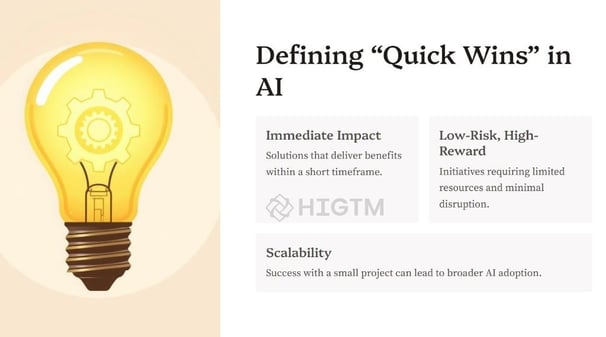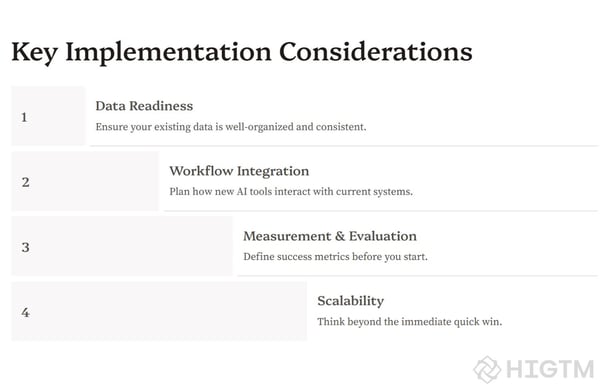11. Quick Wins for SMEs: Simple AI-Driven Improvements
Often, a carefully chosen “quick win” can deliver tangible benefits—like cost savings, operational efficiency, or higher customer satisfaction—in just a few weeks or months. This post spotlights high-impact, low-complexity AI initiatives that SMEs can implement swiftly for rapid returns. By targeting specific pain points—such as repetitive data entry or inconsistent customer support—these early projects serve as proof of concept, building team confidence and demonstrating the real-world potential of AI. Whether you’re considering automated lead scoring, chatbots, or inventory forecasting, the goal is to start small, validate success, and open doors to broader AI adoption down the road.
Q1: FOUNDATIONS OF AI IN SME MANAGEMENT - CHAPTER 1 (DAYS 1–31): CORE AI CONCEPTS & VALUE PROPOSITION
Gary Stoyanov PhD
1/11/20255 min read

1. Defining “Quick Wins” in AI
Quick wins are short-term AI projects that yield fast, measurable improvements. Instead of re-engineering entire workflows, these initiatives focus on a targeted challenge—often involving automation or predictive modeling—that can be resolved with minimal risk and modest resources.
1.1 Key Characteristics
Immediate Impact
Solutions that produce visible benefits (like faster operations, cost savings, or better customer engagement) within weeks or a few months.
Low-Risk, High-Reward
Projects that demand limited data or staff hours, making them easy to scope and test without disrupting daily routines.
Scalability
If the project works well, the same approach can expand to other departments or problems, accelerating AI’s company-wide impact.
1.2 Why Focus on Quick Wins
Team Buy-In: Showing immediate results helps overcome skepticism about AI’s practicality. Employees and executives alike gain confidence in future initiatives.
Data & Process Insights: Even small AI pilots can expose data quality issues or highlight process inefficiencies, paving the way for broader optimization.
Skill-Building: Starting with simpler use cases allows staff to get comfortable with AI tools and methodologies, making more advanced projects easier to tackle later.
Bottom Line: Quick wins provide momentum. They function like stepping stones, laying the groundwork for bigger AI transformations while solidifying internal support and clarifying data requirements.
2. Why Small Steps Matter
Many SMEs hesitate to adopt AI due to concerns over budget constraints, skill gaps, or uncertain ROI. But aiming for a massive AI overhaul can lead to analysis paralysis. A small, focused pilot or project aligns with strategic thinking:
Incremental Progress
A simple, well-scoped AI deployment keeps the risk low. If it fails, lessons are learned quickly and at minimal cost. If it succeeds, the proven value justifies bigger investments.
Managed Expectations
Large-scale AI transformations risk scope creep, ballooning expenses, and staff burnout. An incremental approach clarifies each step, ensuring that each milestone delivers tangible benefits.
Staff Engagement
Employees worry that AI might disrupt their routines or threaten jobs. Early, smaller successes demonstrate how AI eases mundane tasks and allows them to focus on strategic or creative responsibilities.
Practical Example: Imagine an SME that wants to automate nearly all client-facing processes at once. Delays inevitably pile up as different teams coordinate, data is integrated, and new frameworks are tested. Instead, starting with an FAQ chatbot or automated lead scoring provides immediate proof of AI’s value—reducing hesitancy and clarifying the path to more comprehensive solutions.
3. Three Immediate AI Use Cases for SMEs
Below are three quick-win AI projects that many SMEs find especially beneficial. Each addresses a well-defined challenge, requires relatively simple implementations, and offers clear ROI potential.
3.1 Automated Lead Scoring
What It Is
A basic machine learning model ranks leads by their likelihood to convert into customers—factoring in criteria like company size, industry, engagement history, or recent activities (e.g., email clicks).
Benefits
Efficient Sales Outreach: Sales teams focus on high-potential leads first, improving conversion rates while saving time.
Higher Conversion: By targeting qualified prospects, the pipeline becomes more productive.
Rapid Implementation: Many out-of-the-box lead-scoring platforms or autoML tools integrate with standard CRMs, requiring minimal coding or data science.
Implementation Tip
Begin with Historical Data: Use records of past leads and outcomes to train a simple classification or regression model.
Track Metrics: Measure outcomes such as lead response time, conversion rates, or sales cycle duration to refine the model.
ROI Impact
Time Saved: Reps no longer sift through masses of cold leads.
Revenue Lift: Spending energy on more receptive leads boosts sales efficiency.
3.2 AI-Enhanced Customer Support
What It Is
Deploy chatbots or natural language processing (NLP) systems for basic customer interactions—like password resets or delivery status checks—allowing human staff to handle more nuanced or high-value queries.
Benefits
Round-the-Clock Availability: Customers get immediate resolutions at any hour.
Lower Support Costs: Reduced ticket volume means fewer support agents needed for routine tasks.
Scalable Service: Handle sudden query spikes—like new product launches—without hiring additional staff.
Implementation Tip
Start with a FAQ Bot: Preloaded with answers to frequent questions, such as shipping rates or return policies.
Plan for Gradual Upgrades: If the chatbot proves successful, integrate advanced NLP features for more complex queries or multi-language support.
ROI Impact
Improved Customer Satisfaction: Quicker replies keep clients happy.
Data Collection: Logs from user interactions reveal common frustrations or additional sales opportunities.
3.3 Demand Forecasting for Inventory
What It Is
Basic predictive models (like regression or time series forecasting) help SMEs project upcoming product demand based on historical sales, seasonality, and relevant external factors.
Benefits
Optimized Stock: Avoid tying up cash in unneeded items or losing sales due to stockouts.
Efficiency Gains: Automated ordering schedules free employees from constant inventory checks.
Less Waste: Surplus or slow-moving inventory can be minimized, saving warehousing costs.
Implementation Tip
Seasonal & Event Data: Incorporate information about holidays or local events that might spike or slow sales.
Validate & Adjust: Compare model outputs to real-world demand, revising parameters over time for better accuracy.
ROI Impact
Fewer Holding Costs: Precise restocking keeps budgets lean.
Boosted Sales: Meeting demand reliably fosters customer satisfaction and loyalty.
4. Key Implementation Considerations
Though these AI use cases are relatively straightforward, certain foundational elements ensure success, preventing stumbling blocks down the line.
4.1 Data Readiness
Check Data Quality: For lead scoring, do you have consistent lead information? For demand forecasting, is sales history fully captured and error-free?
Start Simple: If you’re short on data science expertise, pick smaller models or use third-party services with automated pipelines.
4.2 Workflow Integration
Map Current Processes: If you’re adding an AI chatbot, how will it escalate complicated issues to human support? If you’re using lead scoring, how do sales reps see the updated lead list?
Reduce Friction: A smooth user experience—for both employees and customers—maximizes the chances of adoption and success.
4.3 Measurement & Evaluation
Define Success: Decide on key metrics like cost reduction, time saved, or revenue increases.
Regular Reviews: Evaluate how the AI model performs monthly or quarterly, adjusting inputs or thresholds to improve accuracy.
4.4 Scalability
Plan for Growth: If your chatbot or lead scoring proves effective, you might expand functionality. Choose frameworks and platforms that scale easily, avoiding expensive rehauls.
5. Conclusion: Building Momentum Through Rapid AI Wins
For SMEs, launching AI can seem daunting, particularly if you envision massive data projects or advanced machine learning requiring specialized teams. In reality, many organizations see robust returns just by automating repetitive tasks or deploying basic predictive solutions. These quick wins deliver tangible benefits—boosting revenue, cutting costs, or lifting customer satisfaction—while proving AI’s value to stakeholders. Once the initial pilot yields positive results, you have evidence to fuel broader, more ambitious initiatives.
Key Takeaways:
Quick Wins Build Momentum: Select short-term AI projects with clear, specific goals, delivering immediate ROI and forging organizational confidence in AI’s potential.
Choose Practical Use Cases: Scenarios like automated lead scoring, NLP chatbots, or demand forecasting typically require minimal data science resources but provide significant operational improvements.
Data & Workflow Essentials: Ensure your data is consistent and have a plan to integrate AI outputs into existing systems. Clean data plus smooth integration accelerate adoption.
Measure & Evolve: Track metrics diligently—sales conversion rates, inventory costs, or customer satisfaction scores—and refine models as you collect new data or feedback.
Lay the Foundation for Larger Efforts: Success in small pilot projects paves the way for advanced AI expansions (e.g., computer vision or deep learning). Keep learning and scaling responsibly.
Ultimately, small steps can lead to big results when executed thoughtfully.
By beginning with a laser focus on one or two pressing pain points, you validate AI’s capabilities in your SME’s context.
From there, it’s far easier to champion broader AI adoption, unlocking new efficiencies and innovations across the enterprise.
If you’d like guidance in selecting or deploying these quick-win projects, HIGTM provides tailored support to ensure your solutions are grounded, strategic, and aligned with long-term goals.




Turn AI into ROI — Win Faster with HIGTM.
Consult with us to discuss how to manage and grow your business operations with AI.
© 2025 HIGTM. All rights reserved.
